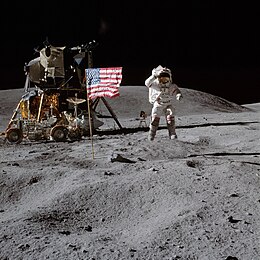Apollo 16

John Young on the Moon, with the Lunar Module and Lunar Rover in the background
|
|
| Mission type | Manned lunar landing |
|---|---|
| Operator | NASA |
| COSPAR ID |
|
| SATCAT № |
|
| Mission duration | 11 days, 1 hour, 51 minutes, 5 seconds |
| Spacecraft properties | |
| Spacecraft |
|
| Manufacturer |
|
| Launch mass | 107,226 pounds (48,637 kg) |
| Landing mass | 11,995 pounds (5,441 kg) |
| Crew | |
| Crew size | 3 |
| Members | |
| Callsign |
|
| EVAs | 1 in cislunar space Plus 4 on the lunar surface |
| EVA duration | 1 hours, 23 minutes, 42 seconds Spacewalk to retrieve film cassettes |
| Start of mission | |
| Launch date | April 16, 1972, 17:54:00 UTC |
| Rocket | Saturn V SA-511 |
| Launch site | Kennedy LC-39A |
| End of mission | |
| Recovered by | USS Ticonderoga |
| Landing date | April 27, 1972, 19:45:05 UTC |
| Landing site | South Pacific Ocean 0°43′S 156°13′W / 0.717°S 156.217°W |
| Orbital parameters | |
| Reference system | Selenocentric |
| Periselene | 20.2 kilometers (10.9 nmi) |
| Aposelene | 108.3 kilometers (58.5 nmi) |
| Epoch | April 20, 1972, 00:27 UTC |
| Lunar orbiter | |
| Spacecraft component | Command/Service Module |
| Orbital insertion | April 19, 1972, 20:22:27 UTC |
| Departed orbit | April 25, 1972, 02:15:33 UTC |
| Orbits | 64 |
| Lunar lander | |
| Spacecraft component | Lunar Module |
| Landing date | April 21, 1972, 02:23:35 UTC |
| Return launch | April 24, 1972, 01:25:47 UTC |
| Landing site |
Descartes Highlands 8°58′23″S 15°30′01″E / 8.97301°S 15.50019°E |
| Sample mass | 95.71 kilograms (211.0 lb) |
| Surface EVAs | 3 |
| EVA duration |
|
| Lunar rover | |
| Distance covered | 26.7 kilometers (16.6 mi) |
| Docking with LM | |
| Docking date | April 16, 1972, 21:15:53 UTC |
| Undocking date | April 20, 1972, 18:07:31 UTC |
| Docking with LM Ascent Stage | |
| Docking date | April 24, 1972, 03:35:18 UTC |
| Undocking date | April 24, 1972, 20:54:12 UTC |
| Payload | |
| Mass |
|
 Left to right: Mattingly, Young, Duke |
|
Apollo 16 was the tenth manned mission in the United States Apollo space program, the fifth and penultimate to land on the Moon and the first to land in the lunar highlands. The second of the so-called "J missions," it was crewed by Commander John Young, Lunar Module Pilot Charles Duke and Command Module Pilot Ken Mattingly. Launched from the Kennedy Space Center in Florida at 12:54 PM EST on April 16, 1972, the mission lasted 11 days, 1 hour, and 51 minutes, and concluded at 2:45 PM EST on April 27.
Young and Duke spent 71 hours—just under three days—on the lunar surface, during which they conducted three extra-vehicular activities or moonwalks, totaling 20 hours and 14 minutes. The pair drove the Lunar Roving Vehicle (LRV), the second produced and used on the Moon, 26.7 kilometers (16.6 mi). On the surface, Young and Duke collected 95.8 kilograms (211 lb) of lunar samples for return to Earth, while Command Module Pilot Ken Mattingly orbited in the Command/Service Module (CSM) above to perform observations. Mattingly spent 126 hours and 64 revolutions in lunar orbit. After Young and Duke rejoined Mattingly in lunar orbit, the crew released a subsatellite from the Service Module (SM). During the return trip to Earth, Mattingly performed a one-hour spacewalk to retrieve several film cassettes from the exterior of the Service Module.
...
Wikipedia

